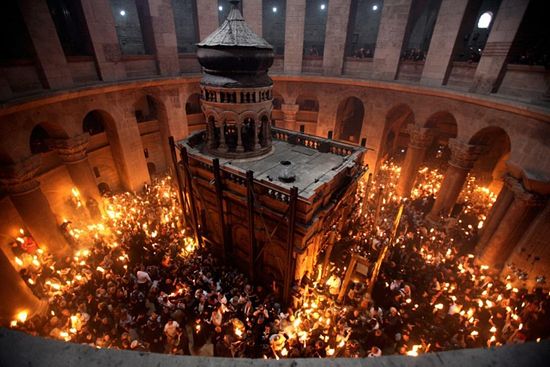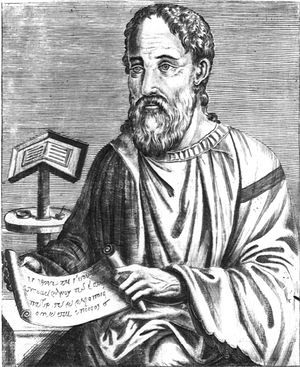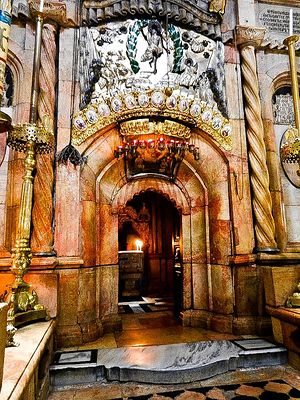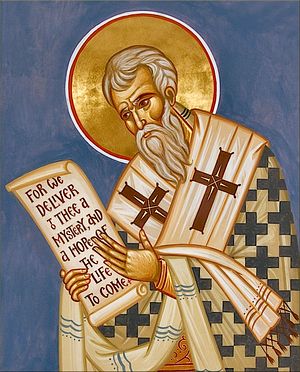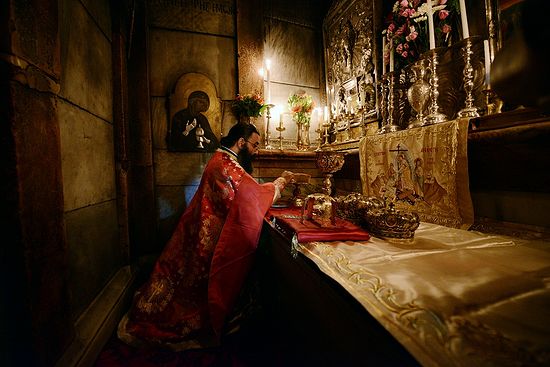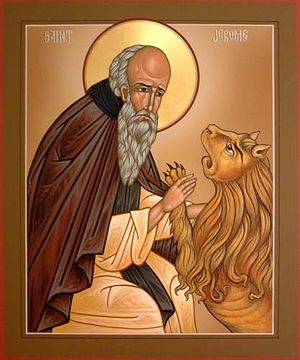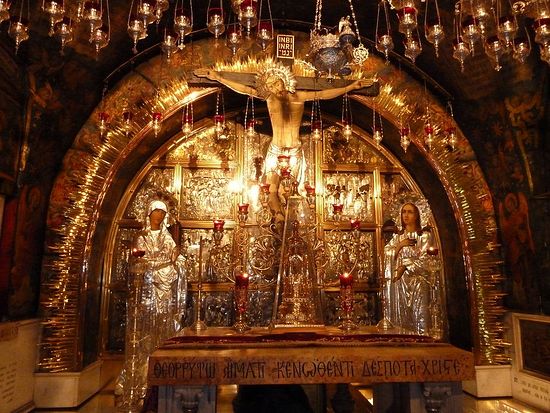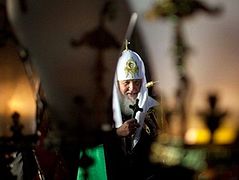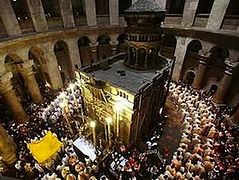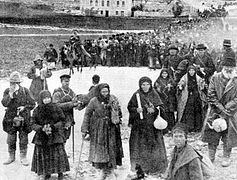The church of the Holy Sepulchre in Jerusalem could be said to be the main church of holy Orthodox. The building includes both Golgotha where our Lord was crucified, and His holy grave, or sepulchre, where He rose again from the dead for the salvation of the world. As such, countless millions of pilgrims have traveled to the Holy Land to venerate the sites in this holy church, since its founding in 326 by the order of Emperor St. Constantine the Great, which is celebrated by the Orthodox Church every year on September 13/26.
Therefore, the annals of Christian history have left us no dearth of information on the founding and history of this holiest of temples. We offer below several excerpts from these sources from the first millennium of Christian history, concerning the construction, layout, holy artifacts and worship in, and the various destructions of the church of the Holy Sepulchre.
* * *
Eusebius of Caesarea, De vita Constantini, 337-340 AD
The historian of Constantine, Eusebius of Caesarea, in his “Life of Constantine” described the works undertaken at the request of Constantine to remove the pagan structures of the Capitolium from the garden of Golgotha. And in the same work he described the new Christian buildings that had been erected to glorify Christ’s Redemption:
Construction of the pagan temples above the site of Golgotha:
This sacred cave, then, certain impious and godless persons had thought to remove entirely from the eyes of men, supposing in their folly that thus they should be able effectually to obscure the truth. Accordingly they brought a quantity of earth from a distance with much labor, and covered the entire spot; then, having raised this to a moderate height, they paved it with stone, concealing the holy cave beneath this massive mound. Then, as though their purpose had been effectually accomplished, they prepare on this foundation a truly dreadful sepulchre of souls, by building a gloomy shrine of lifeless idols to the impure spirit whom they call Venus, and offering detestable oblations therein on profane and accursed altars. For they supposed that their object could not otherwise be fully attained, than by thus burying the sacred cave beneath these foul pollutions. (Book 3, Chapter 26—see also Eusebius’ account concerning Christ’s Tomb)
Description of the demolition carried out at Constantine’s request:
He judged it incumbent on him to render the blessed locality of our Savior's resurrection an object of attraction and veneration to all. He issued immediate injunctions, therefore, for the erection in that spot of a house of prayer: and this he did, not on the mere natural impulse of his own mind, but being moved in spirit by the Savior himself.....but calling on the divine aid, gave orders that the place should be thoroughly purified, thinking that the parts which had been most polluted by the enemy ought to receive special tokens, through his means, of the greatness of the divine favor. As soon, then, as his commands were issued, these engines of deceit were cast down from their proud eminence to the very ground, and the dwelling-places of error, with the statues and the evil spirits which they represented, were overthrown and utterly destroyed.....Nor did the emperor's zeal stop here; but he gave further orders that the materials of what was thus destroyed, both stone and timber, should be removed and thrown as far from the spot as possible; and this command also was speedily executed. The emperor, however, was not satisfied with having proceeded thus far: once more, fired with holy ardor, he directed that the ground itself should be dug up to a considerable depth, and the soil which had been polluted by the foul impurities of demon worship transported to a far distant place. (Book 3, Chapters 25-27)
Discovery of Christ’s Tomb:
...as soon as the original surface of the ground, beneath the covering of earth, appeared, immediately and contrary to all expectation, the venerable and hallowed monument of our Savior's resurrection was discovered. Then indeed did this most holy cave present a faithful similitude of his return to life, in that, after lying buried in darkness, it again emerged to light, and afforded to all who came to witness the sight, a clear and visible proof of the wonders of which that spot had once been the scene, a testimony to the resurrection of the Savior clearer than any voice could give. (Book III, Chapter XXVIII)
...the emperor sent forth injunctions which breathed a truly pious spirit, at the same time granting ample supplies of money, and commanding that a house of prayer worthy of the worship of God should be erected near the Savior's tomb on a scale of rich and royal greatness. This object he had indeed for some time kept in view, and had foreseen, as if by the aid of a superior intelligence, that which should afterwards come to pass. He laid his commands, therefore, on the governors of the Eastern provinces, that by an abundant and unsparing expenditure they should secure the completion of the work on a scale of noble and ample magnificence. (Book 3, Chapter 29)
Description of the Constantinian Basilica:
First of all, then, he adorned the sacred cave itself, as the chief part of the whole work, and the hallowed monument at which the angel radiant with light had once declared to all that regeneration which was first manifested in the Savior's person. This monument, therefore, first of all, as the chief part of the whole, the emperor's zealous magnificence beautified with rare columns, profusely enriched with the most splendid decorations of every kind. The next object of his attention was a space of ground of great extent, and open to the pure air of heaven. This he adorned with a pavement of finely polished stone, and enclosed it on three sides with porticos of great length. For at the side opposite to the cave, which was the eastern side, the church itself was erected; a noble work rising to a vast height, and of great extent both in length and breadth. The interior of this structure was floored with marble slabs of various colors; while the external surface of the walls, which shone with polished stones exactly fitted together, exhibited a degree of splendor in no respect inferior to that of marble. With regard to the roof, it was covered on the outside with lead, as a protection against the rains of winter. But the inner part of the roof, which was finished with sculptured panel work, extended in a series of connected compartments, like a vast sea, over the whole church; and, being overlaid throughout with the purest gold, caused the entire building to glitter as it were with rays of light. Besides this were two porticos on each side, with upper and lower ranges of pillars, corresponding in length with the church itself; and these also had their roofs ornamented with gold. Of these porticos, those which were exterior to the church were supported by columns of great size, while those within these rested on piles of stone beautifully adorned on the surface. Three gates, placed exactly east, were intended to receive the multitudes who entered the church. Opposite these gates the crowning part of the whole was the hemisphere, which rose to the very summit of the church. This was encircled by twelve columns (according to the number of the apostles of our Savior), having their capitals embellished with silver bowls of great size, which the emperor himself presented as a splendid offering to his God. In the next place he enclosed the atrium which occupied the space leading to the entrances in front of the church. This comprehended, first the court, then the porticos on each side, and lastly the gates of the court. After these, in the midst of the open market-place, the general entrance-gates, which were of exquisite workmanship, afforded to passers-by on the outside a view of the interior which could not fail to inspire astonishment. This temple, then, the emperor erected as a conspicuous monument of the Savior's resurrection, and embellished it throughout on an imperial scale of magnificence. He further enriched it with numberless offerings of inexpressible beauty and various materials,--gold, silver, and precious stones, the skillful and elaborate arrangement of which, in regard to their magnitude, number, and variety, we have not leisure at present to describe particularly. (Book 3, Chapters 24-25)
* * *
St. Cyril of Jerusalem, Catechetical Lectures, 347-348 AD
Bishop Cyril, who administered his baptismal catecheses before the Tomb of the Holy Sepulchre in the middle of the 4th century, left in his writing traces of descriptions of the important construction that Constantine’s architects had designed to honor the place of the Resurrection.
Of the excavations carried out in order to build the Edicule around the empty Tomb:
For now it is not to be seen, since the outer cave was cut away at that time for the sake of the present adornment. For before the decoration of the sepulchre by the royal munificence, there was a cave in the front of the rock. But where is the rock that had in it the cave? Does it lie near the middle of the city, or near the walls and the outskirts? And whether is it within the ancient walls, or within the outer walls which were built afterwards? He says then in the Canticles: in a cave of the rock, close to the outer wall. (Book 14, Chapter 9)
Of the Cross at Golgotha:
He was truly crucified for our sins. For if thou wouldest deny it, the place refutes thee visibly, this blessed Golgotha, in which we are now assembled for the sake of Him who was here crucified; and the whole world has since been filled with pieces of the wood of the Cross. (Book 4, Chapter 10)
On the Baptismal rite in the Constantinian Church:
After these things, ye were led to the holy pool of Divine Baptism, as Christ was carried from the Cross to the Sepulchre which is before our eyes. And each of you was asked, whether he believed in the name of the Father, and of the Son, and of the Holy Ghost, and ye made that saving confession, and descended three times into the water, and ascended again; here also hinting by a symbol at the three days burial of Christ. (Book 20, Chapter 4)
* * *
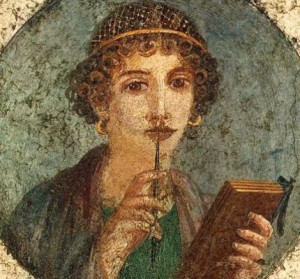
The most famous of the journals of ancient pilgrimages to the Holy Land was the work of a noble woman from Galicia, a province in Spain. The narrative not only recounts details of the voyage she undertook and the sites she visited but also provides a precious source of information on the liturgy followed by the Church of Jerusalem in the 4th century.
Description of the Sunday liturgy at the Basilica of the Holy Sepulchre:
But on the seventh day, that is on the Lord's Day, the whole multitude assembles before cockcrow, in as great numbers as the place can hold, as at Easter, in the basilica which is near the Anastasis, but outside the doors, where lights are hanging for the purpose. And for fear that they should not be there at cockcrow they come beforehand and sit down there. Hymns as well as antiphons are said, and prayers are made between the several hymns and antiphons, for at the vigils there are always both priests and deacons ready there for the assembling of the multitude, the custom being that the holy places are not opened before cockcrow. Now as soon as the first cock has crowed, the bishop arrives and enters the cave at the Anastasis; all the doors are opened and the whole multitude enters the Anastasis, where countless lights are already burning. And when the people have entered, one of the priests says a psalm to which all respond, and afterwards prayer is made; then one of the deacons says a psalm and prayer is again made, a third psalm is said by one of the clergy, prayer is made for the third time and there is a commemoration of all. After these three psalms and three prayers are ended, lo! censers are brought into the cave of the Anastasis so that the whole basilica of the Anastasis is filled with odors. And then the bishop, standing within the rails, takes the book of the Gospel, and proceeding to the door, himself reads the (narrative of the) Resurrection of the Lord. And when the reading is begun, there is so great a moaning and groaning among all, with so many tears, that the hardest of heart might be moved to tears for that the Lord had borne such things for us. After the reading of the Gospel the bishop goes out, and is accompanied to the Cross by all the people with hymns, there again a psalm is said and prayer is made, after which he blesses the faithful and the dismissal takes place, and as he comes out all approach to his hand. And forthwith the bishop betakes himself to his house, and from that hour all the monks return to the Anastasis, where psalms and antiphons, with prayer after each psalm or antiphon, are said until daylight; the priests and deacons also keep watch in turn daily at the Anastasis with the people, but of the lay people, whether men or women, those who are so minded, remain in the place until daybreak, and those who are not, return to their houses and betake themselves to sleep.
Now at daybreak because it is the Lord's Day every one proceeds to the greater church, built by Constantine, which is situated in Golgotha behind the Cross, where all things are done which are customary everywhere on the Lord's Day. But the custom here is that of all the priests who take their seats, as many as are willing, preach, and after them all the bishop preaches, and these sermons are always on the Lord's Day, in order that the people may always be instructed in the Scriptures and in the love of God. The delivery of these sermons greatly delays the dismissal from the church, so that the dismissal does [not] take place before the fourth or perhaps the fifth hour. But when the dismissal from the church is made in the manner that is customary everywhere, the monks accompany the bishop with hymns from the church to the Anastasis, and as he approaches with hymns all the doors of the basilica of the Anastasis are opened, and the people, that is the faithful, enter, but not the catechumens. And after the people the bishop enters, and goes at once within the rails of the cave of the Martyrium. Thanks are first given to God, then prayer is made for all, after which the deacon bids all bow their heads, where they stand, and the bishop standing within the inner rails blesses them and goes out, each one drawing near to his hand as he makes his exit. Thus the dismissal is delayed until nearly the fifth or sixth hour. And in like manner it is done at lucernare [the time when the lamps are lighted], according to daily custom.
This then is the custom observed every day throughout the whole year except on solemn days, to the keeping of which we will refer later on. But among all things it is a special feature that they arrange that suitable psalms and antiphons are said on every occasion, both those said by night, or in the morning, as well as those throughout the day, at the sixth hour, the ninth hour, or at lucernare all being so appropriate and so reasonable as to bear on the matter in hand. And they proceed to the greater church, which was built by Constantine, and which is situated in Golgotha, that is, behind the Cross, on every Lord's Day throughout the year except on the one Sunday of Pentecost, when they proceed to Sion, as you will find mentioned below; but even then they go to Sion before the third hour, the dismissal having been first made in the greater church. (Itinerarium, cap. 24-25)
* * *
St. Jerome, Epistula ad Paulinum, 395 AD
St. Jerome, known as the first translator of the Bible into Latin, lived in Bethlehem from 386 onwards, together with the noble Paula accompanied by her daughter Eustochium and other followers, living a monastic life in the caves around the Grotto of the Nativity of Jesus. In a letter addressed to Paulinus of Nola, St. Jerome offers eyewitness testimony to the condition of Golgotha at the time of Aelia Capitolina:
From the time of Hadrian to the reign of Constantine, a period of about one hundred eighty years, a statue of Jupiter stood on the site of the Resurrection, while a marble status of Venus was placed by the pagans on the rock of the Cross and became an object of worship. The authors of this persecution thought that by defiling the holy places with idols, they could take away our faith in the Resurrection and the Cross.
* * *
Arculf, Adamnanus, De locis sanctis, c. 680 AD
An early eyewitness to the situation following the Arab arrival in Jerusalem, the Frankish bishop Arculf has left us, by the hand of the Irish monk Adamnan to whom he provided a detailed narrative of his pilgrimage, a rich description of the Holy Sepulchre and other places he visited in the Holy City during his stay.
Description of the Lord’s Tomb:
In the middle of the interior of this round house is a round cabin (tugurium) cut out in one and the same rock, in which thrice three men can pray standing; and from the head of a man of ordinary stature as he stands, up to the arch of that small house, a foot and a half is measured upwards. The entrance of this little cabin looks to the east, and the whole outside is covered with choice marble, while its highest point is adorned with gold, and supports a golden cross of no small size. In the northern part of this cabin is the Sepulchre of the Lord, cut out in the same rock in the inside, but the pavement of the cabin is lower than the place of the Sepulchre; for from its pavement up to the edge of the side of the Sepulchre a measure of about three palms is reckoned. So Arculf, who used often to visit the Sepulchre of the Lord and measured it most accurately, told me. (Book 1, Chapter 2)
About the stone that sealed the Tomb:
As to the colors of that rock ... Arculf when questioned by me, said: ‘That Cabin of the Lord's Tomb is in no way ornamented on the inside, and shows even to this day over all its surface the traces of the tools, which the hewers or excavators used in their work: the color of that rock both of the Tomb and of the Sepulchre is not one, but two colors seem to have been intermingled, namely red and white, whence also that rock appears two-colored.’ But as to these points let what has been said suffice. (Book1, chapter 4)
* * *
Patriarch Eutychius of Alexandria, Annals, 10th century
Eutychius, Patriarch of Alexandria, described the events relating to the Arab conquest in 638 AD. It was also Eutychius who provided the account of the visit of Sultan Omar ibn al-Khattab to the Church of the Holy Sepulchre, following which the Sultan forbid Muslims from praying in groups in the atrium of the Christian sanctuary, permitting only individual prayers.
The peaceful agreement for the surrender of Jerusalem by Sophronius to Sultan Omar ibn al-Khattab:
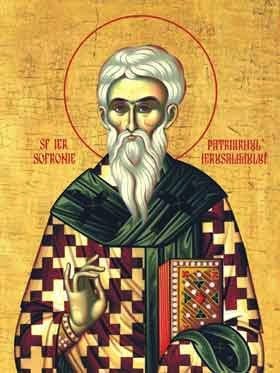 St. Sophronius of Jerusalem
St. Sophronius of Jerusalem * * *
Yahya ibn Sa'id, Annals, 938-1034 AD
The destruction of the Church of the Holy Sepulchre ordered by Hakim, Caliph of Cairo, in 1009 is reported in the “Annals” of the Christian doctor and historian Yahya ibn Sa'id of Antioch, composed in the 11th century.
They seized all the furnishings they found in the church and completely destroyed it, leaving only those things whose destruction would have been too difficult. They also destroyed Calvary and the church of St. Constantine and all that was located within its confines, and they tried to destroy the sacred remains. This destruction began on Tuesday the fifth day before the end of the month of Safar in the year 400 of the Hegira.
* * *
Abbot Daniel, Life and Pilgrimage, 1106-1107
The Ukrainian abbot Daniel, who visited the Holy Places accompanied by a monk from the Mar Saba Monastery, demonstrated a lively curiosity about the sanctuaries and monasteries held by the Greeks as well as the traditions of the Latin Church.
Description of the Church of the Resurrection:
The Church of the Resurrection is of a circular form having twelve monolithic columns and six pillars. Its floor is made of beautiful marble slabs. It has six entrances and tribunes with twelve columns. Lively mosaics of the holy prophets are under the ceiling, over the tribune. The altar is surmounted by a mosaic image of Christ. In the main altar one can see the mosaic of the Exaltation of Adam. In the apse the Ascension of Christ. The Annunciation occupies the two pillars next to the altar. The dome of the church is not closed by a stone vault but is made up of wooden beams in a truss form. In this way the Church has an opening at the top. The Holy Sepulchre stands under this open dome ...

